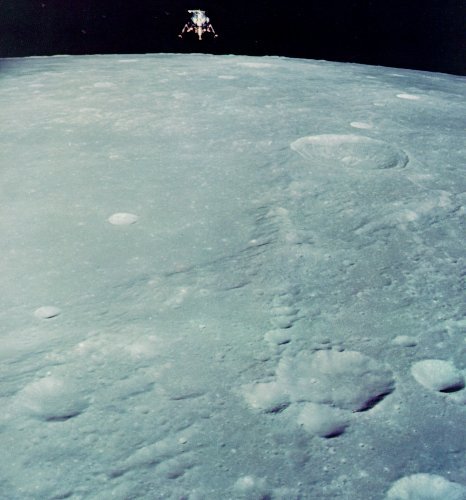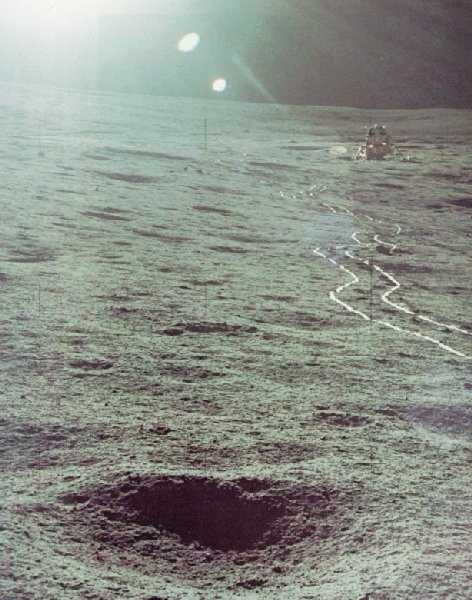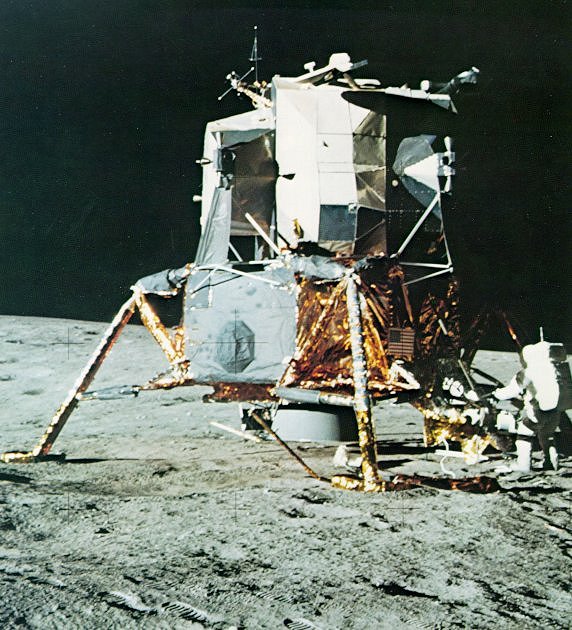Apollo Expeditions to the Moon
LITTLE CLOUDS AROUND YOUR FEET
And the dust! Dust got into everything. You walked in a pair
of little dust clouds kicked up around your feet. We were
concerned about getting dust into the working parts of the
spacesuits and into the lunar module, so we elected to remain in
the suits between our two EVAs. We thought that it would be less
risky that way than taking them off and putting them back on
again.
On the first EVA, the first thing I did was to take the
contingency sample. When Al joined me on the surface, we started
with the experimental setups. We set out the solar wind
experiment and the ALSEP items. We planted the passive seismic
experiment, deployed and aligned antennas, laid out the lunar
surface magnetometer, and took core samples. Some of the
experiments started working right away as planned, sending data
back. Others weren't set to start operating until after we had
left.
We were continually describing what we were doing; we kept
up a stream of chatter so that people on the ground could follow
what was going on if we were to lose the video signal. And we did
lose it, too, soon after we landed. That was hard to take.
| | |
Going its separate way for a landing, the Apollo 12 Lunar Module
Intrepid gleams in the sunlight as it pulls ahead of Yankee Clipper,
the command module. The view is westward, from a circular orbit
69 miles above the surface, with Intrepid very nearly as high. With
the Sun above and behind the camera, the very rough lunar terrain
below appears greatly subdued. The circular crater in the middle
distance on the right is Herschel. The smooth-floored giant crater
Ptolemaeus occupies much of the area to its left.
|
One strange surface phenomenon was a group of conical
mounds, looking for all the world like small volcanoes. They were
maybe five feet tall and about fifteen feet in diameter at the
base. Both of us really enjoyed working on the surface; we took a
lot of kidding later about the way we reacted. But it was
exciting; there we were, the third and fourth people on the Moon,
doing what we were supposed to do, what we had planned to do, and
keeping within schedule. Add to that the excitement of just being
there, and I think we could be forgiven for reacting with
enthusiasm.
| | |
Tire tracks trace the path of the Apollo 14
astronauts from their lunar module Antares to
the site, some 200 yards to the west, where
they set up the Apollo Lunar Surface Experiments
Package (ALSEP). On this mission, they
had a two-wheeled, light, hand-pulled cart
(shown here) to carry their equipment
and samples. The Modular Equipment
Transporter, or MET, had pneumatic tires,
which compacted the soil as they rolled. In
this photo, taken in the direction of the Sun,
the tracks are brightly backlighted. In general,
however, where astronauts worked, the
soil scuffed up by their boots was distinctly
darker than the undisturbed surface material.
|
| | |
Astronaut Alan Bean unloads equipment from
the Apollo 12 lunar module Intrepid in preparation
for the walk to the ALSEP site. The lunar
module-surely the clumsiest-looking flying machine
ever built-consisted of a descent stage, destined
to remain on the Moon, and an ascent stage
that later carried the crew and sampies into
lunar orbit. Scientific equipment and gear for use
an the lunar surface was stowed in four bays
of the descent stage. The panel that covered
the bay facing Bean folded down to provide a work table.
|
Our second EVA was heavily scheduled. We were to make visual
observations, collect a lot more samples, document
photographically the area around the Ocean of Storms, and- if we
could- bring back pieces of the Surveyor III spacecraft. We had
rehearsed that part with a very detailed mockup before the
flight, and were well prepared.
We moved on a traverse, picking up samples and describing
them and the terrain around them, as well as documenting the
specific sites with photography. We rolled a rock into a crater
so that scientists back on Earth could sec if the seismic
experiment was working. (It was sensitive enough to pick up my
steps as I walked nearby.) Anyway, we rolled the rock and they
got a jiggle or two, indicating that experiment was off and
running.
|



